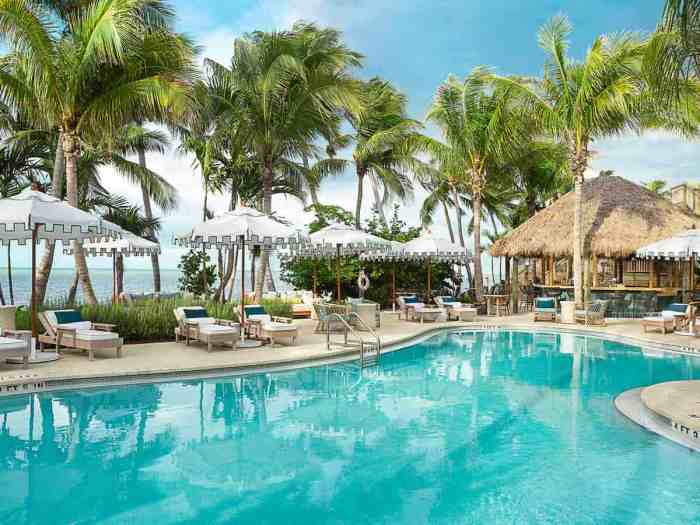All-Inclusive Resorts Your Ultimate Guide
All-Inclusive Resorts offer a unique vacation experience, promising a hassle-free getaway where everything is included in one upfront price. Forget budgeting for meals, drinks, or activities – it’s all taken care of, allowing you to truly relax and enjoy your time away. This comprehensive guide delves into the world of all-inclusive resorts, exploring their various types, locations, pricing structures, and the overall guest experience.
From luxurious escapes in the Caribbean to family-friendly adventures in Mexico, the possibilities are endless. We’ll uncover the factors influencing pricing, the diverse activities and entertainment on offer, and the importance of sustainable practices within the industry. We’ll also explore the future of all-inclusive resorts and what innovations we can expect to see in the coming years. Get ready to discover the perfect all-inclusive escape for your next vacation!
Defining All-Inclusive Resorts
All-inclusive resorts offer a unique vacation experience by bundling the cost of accommodation, meals, drinks, and often a range of activities and amenities into one upfront price. This contrasts sharply with traditional resorts where guests pay separately for each service, leading to potentially unpredictable final costs. The key differentiator lies in the convenience and predictability of all-inclusive pricing, eliminating the need for constant budgeting and individual transactions during the stay.All-inclusive resorts cater to a broad range of travelers seeking a hassle-free and worry-free vacation.
The core appeal is the simplified budgeting and the ease of knowing exactly what’s included. This predictability is particularly attractive to families with children, groups of friends, and those who prefer to relax and enjoy their vacation without constantly monitoring expenses.
Typical Amenities Included in All-Inclusive Packages
The specific amenities offered vary greatly depending on the resort and the chosen package level. However, most all-inclusive resorts typically include accommodation, meals (often at multiple restaurants on-site), snacks, and a selection of alcoholic and non-alcoholic beverages. Many also include access to recreational facilities such as pools, beaches, fitness centers, and various activities like water sports, tennis, or evening entertainment.
Comparison of All-Inclusive Package Levels
The following table compares different levels of all-inclusive packages, highlighting the varying levels of amenities and services provided:
| Feature | Basic | Premium | Luxury |
|---|---|---|---|
| Accommodation | Standard rooms | Upgraded rooms, suites available | Luxury suites, private villas |
| Dining | Buffet restaurants, one à la carte restaurant | Multiple à la carte restaurants, themed nights | Fine dining restaurants, Michelin-starred options (in some cases), private dining experiences |
| Beverages | Limited selection of alcoholic and non-alcoholic beverages | Wider selection of premium alcoholic beverages, specialty cocktails | Top-shelf liquors, premium wines, champagne, personalized cocktail service |
| Activities | Basic water sports, some land activities | Wider range of water sports, land activities, nightly entertainment | Exclusive access to private areas, concierge services, personalized excursions, premium spa treatments |
| Other Amenities | Basic Wi-Fi | High-speed Wi-Fi, access to fitness center | 24-hour butler service, private beach access, unlimited spa treatments |
Target Market for All-Inclusive Resorts
All-inclusive resorts appeal to a diverse target market. Families are a significant segment, drawn to the convenience and predictability of the pricing, ensuring a stress-free vacation for both parents and children. Couples also frequently choose all-inclusive resorts for romantic getaways, appreciating the convenience of having everything included and the opportunity to relax and enjoy each other’s company without the constant concern of additional expenses.
Groups of friends also find all-inclusive resorts to be an ideal choice for celebrations and reunions, facilitating shared experiences and simplifying the planning process. Finally, individuals seeking a relaxing and carefree vacation also represent a significant portion of the target market.
Geographic Locations and Resort Types
All-inclusive resorts offer a convenient and predictable vacation experience, attracting millions of travelers annually. Their popularity is driven by the bundled pricing, which simplifies budgeting and eliminates the surprise costs often associated with traditional travel. The location and type of resort play a significant role in the overall experience, catering to diverse preferences and budgets.
The global appeal of all-inclusive resorts is evident in their widespread presence across various regions. The specific characteristics of each location, including climate, culture, and activities, contribute to the unique character of the resort experience.
Popular Geographic Locations for All-Inclusive Resorts
All-inclusive resorts thrive in warm, sunny destinations with beautiful beaches and ample opportunities for relaxation and recreation. The following list highlights some of the most popular regions globally.
- Caribbean (Dominican Republic, Jamaica, Mexico, Cuba, Barbados)
- Mexico (Riviera Maya, Cancun, Puerto Vallarta)
- Mediterranean (Greece, Turkey, Spain, Italy)
- Central America (Costa Rica, Panama)
- South America (Dominican Republic)
- Indian Ocean (Maldives, Mauritius)
Types of All-Inclusive Resorts
All-inclusive resorts cater to a wide range of travelers, offering diverse options to match individual needs and preferences. This variety ensures that there’s a perfect fit for every type of vacationer.
- Family-Friendly Resorts: These resorts prioritize children, offering kids’ clubs, playgrounds, family-friendly activities, and amenities like cribs and high chairs. Examples often include multiple pools, water parks, and supervised children’s programs. They generally have a lively atmosphere with a focus on shared family experiences.
- Adults-Only Resorts: Designed for couples and adults seeking a relaxing and romantic getaway, these resorts offer a tranquil environment free from the hustle and bustle of children. They often feature luxurious amenities, spa services, and sophisticated dining options, emphasizing relaxation and intimacy.
- Luxury All-Inclusive Resorts: These resorts offer top-tier accommodations, exceptional service, gourmet dining, and exclusive amenities like private butlers, infinity pools, and private beaches. They often feature lavish décor, high-end brands, and curated experiences, providing an ultra-luxurious vacation experience.
- Budget-Friendly All-Inclusive Resorts: These resorts provide a basic but comfortable all-inclusive experience at a more affordable price point. While they may not offer the same level of luxury or amenities as higher-end resorts, they still provide value for money by including meals, drinks, and activities in the overall price.
Regional Comparisons of All-Inclusive Resorts
While all-inclusive resorts share the commonality of bundled pricing, significant differences exist based on their geographic location. These variations impact the overall experience and should be considered when planning a vacation.
Caribbean resorts often emphasize beach activities, watersports, and vibrant nightlife. Mexican resorts frequently blend ancient Mayan culture with modern amenities, offering excursions to archaeological sites alongside luxurious resort experiences. Mediterranean resorts, in contrast, often highlight historical sites, cultural experiences, and stunning coastal landscapes, emphasizing exploration and cultural immersion. Each region offers a unique blend of experiences and caters to different preferences.
Pricing and Value: All-Inclusive Resorts
All-inclusive resorts offer a seemingly simple pricing structure: one upfront cost covers accommodation, meals, drinks, and often activities. However, the actual price varies significantly depending on several interconnected factors, ultimately influencing the perceived value for the guest. Understanding these factors is key to making an informed choice.Factors Influencing All-Inclusive Resort Pricing
Pricing Determinants
Several key factors contribute to the final price of an all-inclusive resort stay. These include location, time of year (seasonality), level of luxury, room type, and the specific amenities and services included in the package. Prime beachfront locations in popular tourist destinations will naturally command higher prices than more remote or less-developed areas. Peak seasons, such as holidays and school breaks, also see a surge in prices, reflecting higher demand.
The level of luxury, encompassing the quality of accommodation, dining options, and available activities, is a major determinant. A luxurious five-star resort will cost considerably more than a three-star option. Finally, the specific room type chosen, ranging from basic rooms to suites with private balconies or ocean views, also impacts the final price.
Pricing Models
All-inclusive resorts employ various pricing models to cater to different budgets and preferences. A common approach is a flat rate per person, per night, which includes all specified amenities. Some resorts offer tiered pricing, with higher prices reflecting superior room categories or additional perks such as access to exclusive lounges or premium alcohol brands. Others might offer packages that include specific activities or excursions at a discounted rate when bundled with the accommodation.
Some resorts also offer flexible payment plans or early booking discounts to encourage reservations. Finally, dynamic pricing, similar to airline ticket pricing, adjusts prices based on real-time demand, with prices fluctuating based on occupancy levels and time until the booking date.
Hypothetical Pricing Comparison
The following table compares the pricing for a seven-night stay for two adults at three different all-inclusive resorts in the Caribbean, showcasing varying levels of luxury. These prices are hypothetical examples and should not be considered actual quotes.
| Resort | Luxury Level | Room Type | Price (USD) |
|---|---|---|---|
| Paradise Cove Resort | Budget-Friendly | Standard Room | $2100 |
| Ocean Breeze Resort & Spa | Mid-Range | Ocean View Room | $3500 |
| Luxury Bay Resort | Luxury | Oceanfront Suite | $7000 |
Activities and Entertainment
All-inclusive resorts pride themselves on offering a diverse range of activities and entertainment options, designed to cater to a wide spectrum of guest preferences and ensure a memorable vacation experience. The availability and type of activities significantly influence the overall appeal and success of the resort, impacting guest satisfaction and repeat bookings.The breadth of activities available is a key differentiator between resorts, and understanding this range is crucial for potential guests choosing their ideal vacation spot.
A well-rounded program contributes to a vibrant and engaging atmosphere, maximizing the value proposition of the all-inclusive package.
Variety of Activities and Entertainment Options
All-inclusive resorts typically offer a wide selection of activities and entertainment to keep guests occupied throughout their stay. The specific offerings vary depending on the resort’s size, location, and target demographic.
- Water Sports: Snorkeling, scuba diving, kayaking, paddleboarding, windsurfing, and sailing are common, often with equipment included in the all-inclusive package. Some resorts even have private beaches with calm waters ideal for families.
- Land-Based Activities: These can range from organized games like volleyball and beach soccer to more structured activities like tennis, golf (sometimes with extra fees), fitness classes (yoga, aerobics, spin), and cooking demonstrations.
- Evening Entertainment: Nightly shows are a staple, often featuring live music, themed parties, cultural performances, or even Broadway-style productions. Some resorts also have casinos, nightclubs, or other late-night entertainment venues.
- Kids’ Clubs and Activities: Family-friendly resorts typically have dedicated kids’ clubs with supervised activities tailored to different age groups. This allows parents some downtime while ensuring their children are entertained and engaged.
- Spa and Wellness: Many all-inclusive resorts offer spa services, ranging from massages and facials to hydrotherapy and other wellness treatments. These services often come at an additional cost, even within an all-inclusive package.
- Excursions and Tours: Some resorts arrange day trips and excursions to local attractions, historical sites, or natural wonders. These often involve an extra fee but provide opportunities to explore the surrounding area.
Importance of Diverse Activities in Attracting Guests
The diversity of activities offered directly impacts a resort’s ability to attract a broad range of guests. Couples seeking a romantic getaway might prefer quieter evenings with live music and access to a luxurious spa, while families with young children prioritize kids’ clubs, shallow pools, and age-appropriate entertainment. Adventure-seekers might be drawn to resorts with a wide range of water sports and land-based activities.
Offering a diverse selection allows the resort to appeal to a wider market segment and maximize occupancy rates. For example, a resort that only offers water sports will likely miss out on attracting guests interested in land-based activities or evening entertainment.
Comparison of Entertainment in Family-Friendly vs. Adults-Only Resorts
Family-friendly and adults-only all-inclusive resorts cater to vastly different demographics, resulting in significant differences in their entertainment offerings. Family-friendly resorts prioritize activities suitable for all ages, with a strong emphasis on kids’ clubs, daytime entertainment that doesn’t disrupt family time, and early evening shows appropriate for children. Adults-only resorts, on the other hand, focus on a more sophisticated and relaxed atmosphere.
They often feature upscale dining options, lively nightclubs, adult-oriented shows, and a more vibrant nightlife scene. For example, a family-friendly resort might host a pirate-themed treasure hunt during the day and a family-friendly magic show in the evening, while an adults-only resort might offer mixology classes, a silent disco, and live music from a local band.
Food and Beverage
All-inclusive resorts pride themselves on their diverse and plentiful food and beverage offerings, a key component of the overall vacation experience. Guests expect a wide array of choices, catering to various tastes and dietary needs, all included in the price of their stay. This goes beyond simply providing meals; it’s about creating memorable culinary moments that enhance the overall holiday.The role of culinary diversity in enhancing the guest experience is paramount.
A resort offering only one type of cuisine risks alienating a significant portion of its clientele. By providing a variety of options – from international buffets to themed restaurants, from casual snack bars to upscale dining experiences – resorts cater to a broader range of preferences and ensure guest satisfaction. This diversity also contributes to a richer and more immersive cultural experience for travelers, allowing them to explore different flavors and culinary traditions from around the world without leaving the resort.
Dining Experiences at All-Inclusive Resorts
All-inclusive resorts typically offer a range of dining experiences to suit different preferences and occasions. Buffets are common, providing a wide selection of dishes for breakfast, lunch, and dinner. These buffets often feature themed nights, such as Mexican Fiesta or Italian Feast, adding variety and excitement. In addition to buffets, many resorts boast a selection of à la carte restaurants, specializing in different cuisines, such as Italian, Mexican, Asian, or seafood.
These restaurants often require reservations, offering a more formal and intimate dining experience. Many resorts also include casual eateries, snack bars, and cafes, providing convenient options throughout the day. Room service is another common amenity, allowing guests to enjoy meals in the comfort of their own rooms. The specific offerings will vary depending on the size and luxury level of the resort.
Sample All-Inclusive Resort Menu
| Breakfast | Lunch | Dinner | Snacks/Drinks |
|---|---|---|---|
| Continental Breakfast (pastries, fruit, yogurt) | Casual Buffet (sandwiches, salads, pizza) | Italian Restaurant (Pasta, Pizza, Risotto) | Ice Cream Parlor |
| Full American Breakfast (eggs, bacon, pancakes) | Beachside Grill (burgers, hot dogs, fries) | Mexican Restaurant (Tacos, Enchiladas, Fajitas) | Poolside Bar (cocktails, juices, beer) |
| Omelet Station | Poolside Snack Bar (salads, wraps) | Steakhouse (Various Steaks, Sides) | Lobby Bar (Wine, Cocktails, Coffee) |
| Fresh Fruit Platter | Deli Sandwiches | Seafood Restaurant (Grilled Fish, Lobster) | 24-Hour Room Service |
Sustainability and Environmental Impact
All-inclusive resorts, while offering a convenient and seemingly carefree vacation experience, often face scrutiny regarding their environmental footprint. The sheer scale of these resorts, coupled with high guest numbers and resource consumption, can place significant strain on local ecosystems and natural resources. However, growing awareness of these impacts has spurred the industry to adopt more sustainable practices, striving for a balance between economic prosperity and environmental protection.The environmental impact of all-inclusive resorts is multifaceted.
High energy consumption from air conditioning, lighting, and water heating contributes to greenhouse gas emissions. Waste generation, from food scraps to single-use plastics, poses a significant challenge for waste management systems in often already fragile environments. Water usage for swimming pools, landscaping, and guest amenities can deplete local water resources, especially in arid or water-stressed regions. Furthermore, the construction of resorts can lead to habitat destruction and biodiversity loss.
The increased demand for local resources, such as food and building materials, can also strain local ecosystems and communities.
Sustainable Practices in All-Inclusive Resorts
Many all-inclusive resorts are actively implementing sustainable practices to mitigate their environmental impact. These initiatives often involve a multifaceted approach encompassing energy efficiency, water conservation, waste reduction, and responsible sourcing. For example, some resorts are investing in renewable energy sources like solar panels to reduce their reliance on fossil fuels. Water conservation measures include installing low-flow fixtures, implementing rainwater harvesting systems, and using treated wastewater for irrigation.
Waste management programs often involve composting food scraps, recycling materials, and reducing single-use plastics. Responsible sourcing focuses on procuring locally-sourced food and building materials to reduce transportation emissions and support local economies. Some resorts are also partnering with local conservation organizations to protect surrounding ecosystems and participate in environmental restoration projects.
Challenges and Opportunities for Environmentally Responsible Tourism
The transition to environmentally responsible tourism within the all-inclusive resort sector presents both significant challenges and substantial opportunities. One key challenge lies in balancing the economic demands of the industry with the need for environmental protection. Implementing sustainable practices often involves upfront investment costs, which can be a barrier for some resorts. Furthermore, monitoring and enforcing sustainable practices across a large resort complex can be logistically complex.
Another challenge involves engaging and educating guests about sustainable tourism practices and encouraging their participation.Despite these challenges, there are significant opportunities for environmentally responsible tourism. The growing demand for sustainable travel among consumers creates a market incentive for resorts to adopt eco-friendly practices. Certifications and eco-labels, such as LEED certification or Green Globe certification, can help resorts demonstrate their commitment to sustainability and attract environmentally conscious travelers.
Collaboration between resorts, local communities, and governmental agencies is crucial for developing and implementing effective sustainable tourism strategies. Technological advancements in renewable energy, water treatment, and waste management also offer new possibilities for reducing the environmental impact of all-inclusive resorts. By embracing these opportunities and addressing the challenges, the all-inclusive resort sector can contribute to a more sustainable and responsible tourism industry.
Guest Experience and Satisfaction
Creating a memorable and positive guest experience is paramount for the success of any all-inclusive resort. It’s not just about offering a luxurious stay; it’s about crafting an entire vacation experience that exceeds expectations and fosters loyalty. This involves a multifaceted approach encompassing various aspects of the resort’s operations and services.Key factors contributing to positive guest experiences at all-inclusive resorts are numerous, but several consistently stand out.
These elements work together to create a seamless and enjoyable vacation.
Factors Contributing to Positive Guest Experiences
A positive guest experience is built on a foundation of several key factors. Exceptional service, personalized attention, and a wide array of amenities and activities all contribute to a highly rated stay. Cleanliness, comfortable accommodations, and efficient operations are equally crucial for maintaining high standards.
- Exceptional Service: Friendly, attentive, and efficient staff who anticipate guest needs and resolve issues promptly are vital. This includes prompt room service, helpful concierge assistance, and readily available staff throughout the resort.
- High-Quality Accommodations: Clean, well-maintained rooms and suites with comfortable beds, modern amenities, and pleasing aesthetics are fundamental. Attention to detail, such as fresh linens and readily available toiletries, enhances the experience.
- Diverse Activities and Amenities: A wide range of activities, from water sports and fitness classes to cultural excursions and evening entertainment, caters to diverse interests and keeps guests engaged. Well-maintained pools, beaches, and other recreational areas are also essential.
- Delicious Food and Beverage Options: A variety of high-quality dining options, including themed restaurants, buffets, and bars, caters to different tastes and preferences. Fresh, locally sourced ingredients whenever possible further enhance the dining experience.
- Personalized Attention: Remembering guest preferences and providing personalized service, such as greeting guests by name or offering tailored recommendations, creates a welcoming and memorable experience. This can involve small gestures, such as a welcome gift or a handwritten note.
Strategies for Improving Guest Satisfaction and Loyalty
Strategies to enhance guest satisfaction and cultivate loyalty often involve proactive measures and a commitment to continuous improvement. Gathering feedback, implementing changes based on that feedback, and creating loyalty programs are all important elements.
- Proactive Guest Communication: Regular communication with guests, such as pre-arrival emails with helpful information or personalized messages during their stay, enhances the overall experience. This also provides opportunities to address potential concerns before they arise.
- Effective Complaint Resolution: A well-defined process for handling guest complaints and resolving issues promptly and fairly is essential. Empowering staff to resolve issues on the spot, whenever possible, demonstrates a commitment to guest satisfaction.
- Loyalty Programs: Rewarding repeat guests with exclusive benefits, such as discounts, upgrades, or special amenities, encourages loyalty and builds long-term relationships. These programs can include tiered levels based on the number of stays or total spending.
- Staff Training and Development: Investing in staff training to enhance their skills and knowledge ensures that they can provide exceptional service and handle guest requests effectively. Regular training sessions on customer service, conflict resolution, and product knowledge are crucial.
- Continuous Improvement Initiatives: Regularly reviewing guest feedback and implementing changes based on that feedback demonstrates a commitment to continuous improvement. This could involve updating amenities, improving services, or modifying resort policies.
Designing a Guest Feedback Survey
A well-designed guest feedback survey is a valuable tool for gathering insights into guest experiences and identifying areas for improvement. The survey should be concise, easy to complete, and focus on key aspects of the guest experience.A well-structured survey includes a mix of question types, such as multiple-choice, rating scales, and open-ended questions. The use of rating scales (e.g., on a scale of 1 to 5) allows for quantitative analysis, while open-ended questions provide valuable qualitative feedback.
For example, a survey could include questions about the cleanliness of the room, the friendliness of the staff, the quality of the food, and overall satisfaction with the resort. The results can be analyzed to identify trends and areas needing improvement. The data gathered can then inform decisions regarding service improvements, staff training, and resort upgrades. For instance, consistently low ratings for a particular restaurant might lead to changes in the menu, staff training, or even a renovation.
The Future of All-Inclusive Resorts
The all-inclusive resort model, once a niche vacation option, has become a dominant force in the travel industry. Its continued success hinges on adaptation and innovation, responding to evolving guest expectations and technological advancements. The next decade will see significant shifts in how these resorts operate, cater to guests, and contribute to their destinations.
Emerging trends are reshaping the all-inclusive landscape, driven by both guest demand and technological capabilities. Sustainability initiatives are no longer optional but are becoming essential for attracting environmentally conscious travelers. Personalization of experiences, leveraging technology to anticipate and meet individual guest needs, is also gaining traction. Furthermore, the industry is seeing a rise in unique resort concepts, moving beyond the traditional beach-centric model to encompass diverse experiences and locations.
Technological Advancements and the All-Inclusive Experience
Technology is poised to revolutionize the all-inclusive experience, enhancing convenience, personalization, and overall guest satisfaction. Mobile apps are becoming increasingly sophisticated, allowing guests to manage reservations, order room service, book activities, and access resort information with ease. Artificial intelligence (AI) is being integrated to personalize recommendations, predict guest needs, and streamline operational efficiency. For example, AI-powered chatbots can handle common guest inquiries, freeing up staff to focus on more complex issues.
Biometric technology, while still emerging, could streamline check-in/check-out processes and enhance security. Imagine a future where facial recognition unlocks your room and seamlessly integrates with your resort spending account.
Predictions for the Next 5-10 Years
Within the next five to ten years, we can expect to see several key changes in the all-inclusive sector. Firstly, a greater emphasis on wellness and health will drive the creation of resorts focused on holistic well-being, offering specialized programs and facilities beyond traditional spas. We’ll see more resorts incorporating sustainable practices, not just as a marketing tactic, but as a core part of their business model, possibly through partnerships with local communities and conservation organizations.
Think of resorts powered by renewable energy sources and actively involved in protecting local ecosystems. Secondly, the rise of “bleisure” travel (blending business and leisure) will influence the design and amenities offered, with dedicated workspaces, high-speed internet, and meeting facilities becoming standard. Finally, hyper-personalization will become the norm, with AI and data analytics used to create bespoke experiences for each guest, from customized itineraries to tailored dining options.
Examples of this can already be seen in luxury hotels that use guest data to personalize room settings and amenity selections.
Conclusion

Source: luxatic.com
Ultimately, the appeal of all-inclusive resorts lies in their convenience and value. They offer a stress-free vacation experience, allowing travelers to focus on relaxation and creating lasting memories. Whether you’re seeking a romantic getaway, a family adventure, or a luxurious escape, the diverse range of all-inclusive resorts caters to every taste and budget. By understanding the nuances of pricing, amenities, and location, you can choose the perfect resort to match your ideal vacation, ensuring an unforgettable experience from start to finish.
General Inquiries
What’s the best time of year to visit an all-inclusive resort?
The best time depends on the location and your preferences. Generally, shoulder seasons (spring and fall) offer pleasant weather and fewer crowds than peak summer months.
Are gratuities included in all-inclusive packages?
Gratuities are usually included in the price for most services, but it’s always a good idea to check the specific resort’s policy. For exceptional service, additional tips are always appreciated.
Can I bring my pet to an all-inclusive resort?
Pet policies vary widely. Some resorts are pet-friendly, while others are not. Always check with the resort directly before booking.
What if I have dietary restrictions or allergies?
Most all-inclusive resorts can accommodate dietary restrictions and allergies. Inform the resort of your needs in advance, and they will do their best to meet your requirements.
What happens if a hurricane or other natural disaster affects my trip?
Travel insurance is highly recommended. It can cover cancellations, disruptions, and other unforeseen circumstances. Check your resort’s cancellation policy as well.







